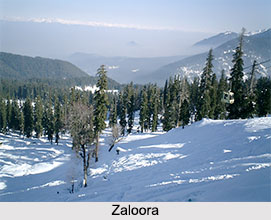 Zaloora is a hilly town of over 6,000 people, noted for the mountain hiking possibilities.
Zaloora is a hilly town of over 6,000 people, noted for the mountain hiking possibilities.
Location of Zaloora
Zaloora is located in northern Baramulla district, Jammu and Kashmir.
History of Zaloora
Zaloora`s long history allegedly began when the lake that covered Kashmir drained, and settlers moved in. Archaeological findings near the hem of the mountains that ring the village seem to confirm that Zaloora was home to fisherman. During the peak of the Buddhist era in Jammu and Kashmir, Zaloora is said to have been home to a Bodvihar, sanctifying it as a place of religion and learning. During the reign of Delhi Sultanate and the Mughal Emperors, holy man Haji Lolo Reshi Baba Sahib, along with disciples, settled in Zaloora. The legend has it that he went on Haj 12 times from here.
Geography of Zaloora
Zaloora is located approximately 16 kilometres (10 mi) from Sopore. Zaloora is a valley within the valley, fenced by mountains on three sides and by Lal Kul canal on the other.
Demography of Zaloora
Zaloora has 10 mohallas and approximately 7,000 inhabitants. The town had a sizable population of Hindus, but most left during the Pandit migration of the early 1990s. The name may be derived from "Zaal" ("fishing net").
Education of Zaloora
Zaloora is one of the most literate villages in Baramulla District. Several mohallas conducted programs to boost literacy rates and were the key to that achievement. The village has two high schools, one government-run, the other privately owned, four middle schools, five primary schools and was the first higher-educational village in Baramulla.
Tribes in Zaloora
Zaloora is the abode of tribal population. The Lone tribe is based mainly in northern Kashmir, although they gradually diffused throughout the valley. Members live in Zaloora and Sopore. The Baht (meaning "priest" or "scribe" in Sanskrit) are found commonly in states in Jammu and Kashmir and elsewhere in India. "Sheikh" (or "Sheik") is an Arabic honorific meaning "elder". The origin of Gujar peoples in Zaloora is uncertain. They are now well-settled in Zaloora and speak Gujree. This tribe is classified as "Other Backward Class" (OBC). "Mir" is a title derived from the Arabic title (as "Emir"). It was given to great leaders during ancient times. Among Muslims, "Mir" became a synonym of "sayyid" as meaning a "relative of Prophet Muhammad". The Mir family have a separate mahalla called "Mir Mahalla zaloora".
Related Articles
Cities of Jammu and Kashmir
Baramulla District
Jammu and Kashmir
Baramulla



















